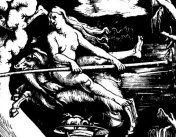 I’ve just found this fascinating discussion on the psychopharmacology of ‘witches ointments’, that supposedly allowed 16th century witches to ‘fly’.
I’ve just found this fascinating discussion on the psychopharmacology of ‘witches ointments’, that supposedly allowed 16th century witches to ‘fly’.
It’s from a fantastic 1998 Anesthesiology article about atropine containing plants, like belladona, deadly nightshade and hemlock, and their effects.
De Laguna was not the sole commentator about the relationship of mind‐altering drugs and witchcraft in the 16th century. In De Praestigiis Daemonum, which Freud called one of the 10 most significant books of all time, Johann Weyer (1515–1588 CE) concluded henbane was a principal ingredient of witches’ brew, along with deadly nightshade and mandrake.According to Weyer, there were other ointments, but the essential ingredients remained the same in all. The preparations, when applied to the upper thighs or genitals, were said to induce the sensation of rising into the air of flying.
Witches were thought to anoint a chair or broomstick with the devil’s ointment, and after self‐application, would fly through the air to meet for devil worship at the sabbat. Francis Bacon (1561–1626 CE) observed that “… the witches themselves are imaginative, and believe oftentimes they do that, which they do not … transforming themselves into other bodies … not by incantations or ceremonies, but by ointments, and annointing themselves all over.”
In an extensive review of psychotropic plant ointments of the Renaissance, Piomelli and Pollio examined transcripts of witchcraft trials, writings on demonology, and the botanical composition of ointments that alleged witches used on themselves during the 15th and 16th centuries.
Despite the difficulty with accurate identification of the plants, the documents reported consistent pharmacologic effects. Further, the biochemical logic of applying these plants in a fat‐based unguent was sound, as it would promote passage of the alkaloids through the intact skin and mucosa.
The use of soot (slightly alkaline) likely would enhance the passage of organic bases because a weakly alkaline environment would be sufficient to neutralize the positive ionic charge. That this is an effective ethnobotanical technique may be seen with Peruvian coca chewers, who mix in their mouths the cocaine‐containing leaves with alkaline cinders to enhance uptake.
There is even experimental evidence for believing that a fatty base was used in these ointments; an ointment from the 13th or 14th century, found accidentally, was subjected to chemical analysis and had an animal fat content of 40%.
The full article is well worth checking out as it tackles how the plants have been used in potions and preparations through history and were a early form of anaesthesia in ancient and medieval surgery.
Link to Anesthesiology article.
No comments:
Post a Comment